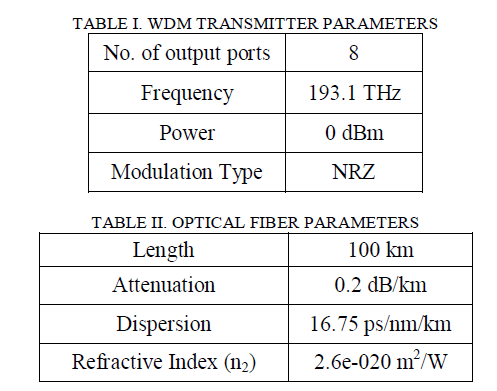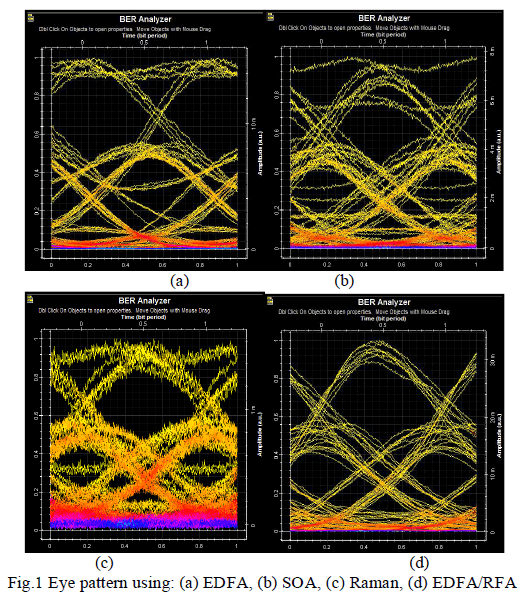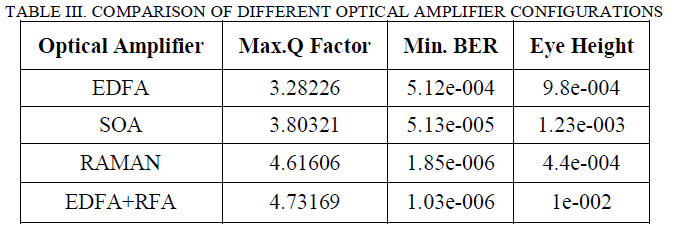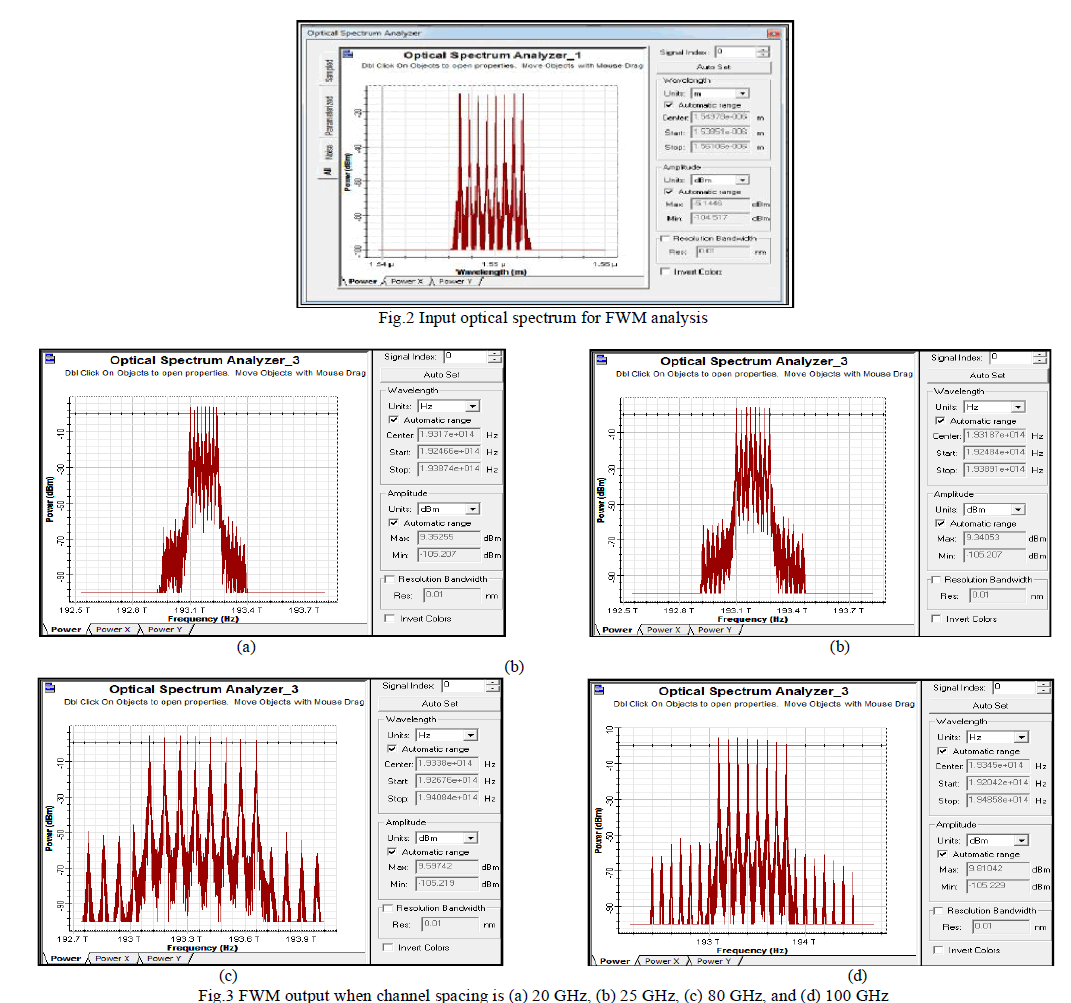ISSN ONLINE(2320-9801) PRINT (2320-9798)
ISSN ONLINE(2320-9801) PRINT (2320-9798)
Lekshmi.S.R1, Sindhu.N2
|
| Related article at Pubmed, Scholar Google |
Visit for more related articles at International Journal of Innovative Research in Computer and Communication Engineering
To eliminate the drawbacks of repeaters, optical amplifiers are used in WDM systems nowadays, which amplify the entire WDM signal directly in the optical domain itself. Yet, one of the serious issues that are faced by a WDM system is Four Wave Mixing (FWM). FWM is a nonlinear phenomenon that occurs when light of two or more different wavelengths is launched into a fiber. In this paper, comparison of different optical amplifier configurations is done and spectral response of FWM is studied. On analysing the performance of different optical amplifier configurations, it was found that Hybrid Erbium-Doped Fiber/Raman Fiber Amplifier (EDF/RFA) gives a better performance in WDM systems. Also, as the channel spacing increases, the nonlinear effect known as FWM is found to be decreasing.
Keywords |
| Wavelength Division Multiplexing; Erbium-Doped Fiber Amplifier; Four Wave Mixing; Inter-Symbol Interference; Bit Error Rate |
INTRODUCTION |
| Optical fiber amplifiers are purely optical in nature and require no high-speed circuitry. The signal is optically amplified in strength by several orders of magnitude without being limited by any electronic bandwidth. The shift from regenerators to amplifiers thus permits a dramatic increase in capacity of the transmission system. Optical amplifiers play an important role in increasing the capacity of optical communication systems using such amplifiers. The most commercially used fiber optical amplifier is Erbium Doped Fiber Amplifier (EDFA). |
| Nonlinear fiber optics deals with the nonlinear optical phenomenon occurring inside optical fibers. Nonlinear effects in optical fiber occur either due to intensity dependence of refractive index of the medium or due to inelastic-scattering phenomenon. The power dependence of the refractive index is known as Kerr-effect. Depending upon the type of input signal, the Kerr nonlinearity manifests itself in three different effects such as Self-Phase Modulation (SPM), Cross- Phase Modulation (XPM) and Four Wave Mixing (FWM). At high power level, the inelastic scattering phenomenon can induce stimulated effects such as Stimulated Brillouin-Scattering (SBS) and Stimulated Raman-Scattering (SRS). These nonlinear effects degrade system performance. The main objective of this paper is to evaluate FWM in WDM using FBG. |
| The rest of the paper is as follows. Section II briefly discusses about Optical Amplifiers and Four-Wave Mixing. Section III deals with the simulation set up followed by results and analysis in Section IV. Finally we conclude with the insights to future works in Section V. |
II. THEORETICAL BACKGROUND |
A. Optical Amplifiers: |
| An optical amplifier is a device that amplifies an optical signal directly, without the need to first convert it to an electrical signal. Optical amplifiers were classified on the basis of device characteristics i.e., whether it is based on linear characteristics (Semiconductor optical amplifier and Rare-earth doped fiber amplifiers) or nonlinear characteristics (Raman amplifiers and Brillouin amplifiers). Optical amplifiers were also classified on the basis of structure i.e., whether semiconductor based (SOAs) or fiber based (Rare-earth doped fiber amplifiers), Raman and Brillouin amplifiers. |
| Erbium-Doped Fiber Amplifier (EDFA) requires lesser power for the pump source and inserting EDFA before the optical splitter greatly increases the output power. Raman Fiber Amplifiers (RFA) can be used as a standalone amplifier or as a distributed amplifier in conjunction with EDFA. SOA has the advantage of smaller size and lower power consumption. Hybrid amplifiers such as EDF/RFA allow fast gain dynamics, simultaneous large bandwidth amplification and ability to provide gain at any wavelength. |
B. Four Wave Mixing: |
| Four-Wave Mixing (FWM) is an intermodulation phenomenon in non-linear optics, whereby interactions between two or more wavelengths produce new wavelengths in the signal. The origin of FWM process lies in the nonlinear response of bound electrons of a material to an applied optical field [1]. In fact, the polarization induced in the medium contains not only linear terms but also the nonlinear terms. The magnitude of these terms is governed by the nonlinear susceptibilities of different orders. The FWM process originates from third order nonlinear susceptibility (χ(3)). If three optical fields with carrier frequencies ω1, ω2 and ω3, co-propagate inside the fiber simultaneously, (χ(3)) generates a fourth field with frequency ω4, which is related to other frequencies by a relation, ω4 = ω1 ± ω2 ± ω3. SPM and XPM are significant mainly for high bit rate systems, but the FWM effect is independent of the bit rate and is critically dependent on the channel spacing and fiber dispersion. The interference FWM caused in WDM systems is known as interchannel crosstalk. |
III. SIMULATION SETUP |
| An 8-channel WDM transmitter is proposed and simulated in this paper using OptiSystem 13 software. NRZ modulation format is used in this system since it has less sensitive to noise compared to other modulation formats in a WDM system from our previous works. The frequency range of WDM signals range from 193.1 THz to 193.8 THz and the frequency spacing is 100GHz. Optical Spectrum Analysers are placed in the set up to view the effects of FWM. The parameters of WDM transmitter and Optical Fiber used in this simulation are listed in TABLE I and TABLE II respectively. |
 |
| The first phase of simulation is done using different optical amplifier configurations. In the final phase, an experimental setup is simulated with the help of EDFA to study the effects of FWM. EDFA is used since it is the commercially and easily available optical amplifier. Various methods have been proposed and theoretically compared to reduce Four Wave Mixing effect. Comparison of power penalty for different fiber lengths and dispersion values has been done but the comparison on the basis of different spacing between input channels is rarely considered. According to ITU-IT standards, four wave mixing effect have been evaluated above channel spacing of 25 GHz. Here, comparison of Four Wave Mixing is done for different values of spacing i.e. 20 GHz, 25 GHz, 80 GHz, and 100 GHz. |
IV. RESULTS AND DISCUSSION |
 |
 |
| Eye height is a measure of the vertical opening of an eye diagram. Noise on the eye will cause the eye to close and hence the eye height measurement determines eye closure due to Intersymbol Interference (ISI). From TABLE I it is clear that Q factor is maximum for Hybrid EDF/RFA Amplifier and lowest for EDFA. The Bit Error Rate is lower for Hybrid EDF/RFA and higher for EDFA and the eye height is maximum for Hybrid EDF/Raman and minimum for Raman amplifier. |
| Finally, with the help of OSA, the 8 channel input to the optical fiber from the transmitter (as shown in Fig.2) and the input to the receiver after travelling through the fiber, optical amplifiers and FBG are viewed at different wavelength channel spacing, i.e., at 20GHz, 25GHz, 80GHz and 100GHz which is shown in Fig.3. |
 |
| The above spectra show that as the spacing between the input channels/users increases, the four wave mixing effect goes on decreasing. The unwanted peaks are more when the spacing is 20 GHz and are less when the spacing is 80 GHz. Again at 100GHz channel spacing, the unwanted peaks arise. This shows that lesser the spacing between different input users/channels, more is the interference between the input frequencies i.e. more is the four wave mixing effect. But the optimized value for channel spacing in WDM systems is 80GHz. On increasing the channel spacing further beyond 80GHz, the unwanted peaks start arising. The interference FWM caused in WDM systems is called crosstalk. |
V. CONCLUSION AND FUTURE WORK |
| An 8 channel WDM system was implemented and simulated successfully in OptiSystem 13. The main motivation of this work was to study the characteristics of different optical amplifier configurations and also to evaluate the spectral response of FWM. The performance of single and hybrid optical amplifiers were compared using BER, Q factor and eye height. It was found that the Hybrid EDF/Raman configuration has a better performance in long-haul communication since it has lower BER, high Q factor and maximum eye height. |
| FWM, which is a nonlinear effect in optical fibers, can be reduced by increasing the channel spacing but the optimized channel spacing is 80GHz. But increasing the channel spacing is a worst case in long haul fiber optic communication. Thus FWM has severe effects in long-haul optical communication systems. |
| In continuation of our research, we would like to study other non-linear effects such as Self Phase Modulation, Cross Phase Modulation, Stimulated Raman Scattering and Stimulated Brillouin Scattering in different optical amplifier configurations. It is also very important to know which are the physical phenomena intervening in an FWM process, and to determine how they relate with each other. Some of the phenomena that have been recognised as the major contributors to the FWM interaction are carrierdensity pulsation, carrier heating, and spectral hole burning [6]. More works could be done to study the spectral response of FWM under these phenomena. |
References |
|